A Detailed Review of Organic Rankine Cycles Driven by Combined Heat Sources
Abstract
1. Introduction
1.1. General Information for Renewables and ORC
1.2. Design Aspects of Combined Heat Sources
1.2.1. Series Configurations of Combined Sources
1.2.2. Parallel Configurations of Combined Sources
1.2.3. Heat Upgrade Configurations of Combined Heat Sources
1.3. ORC Basic Mathematical Formulation
1.3.1. First-Law Efficiency
1.3.2. Second-Law Efficiency
1.4. Contribution of the Present Work
2. Solar–Geothermal ORC
2.1. Series Configurations with Solar–Geothermal ORC
2.2. Parallel Configurations with Solar–Geothermal ORC
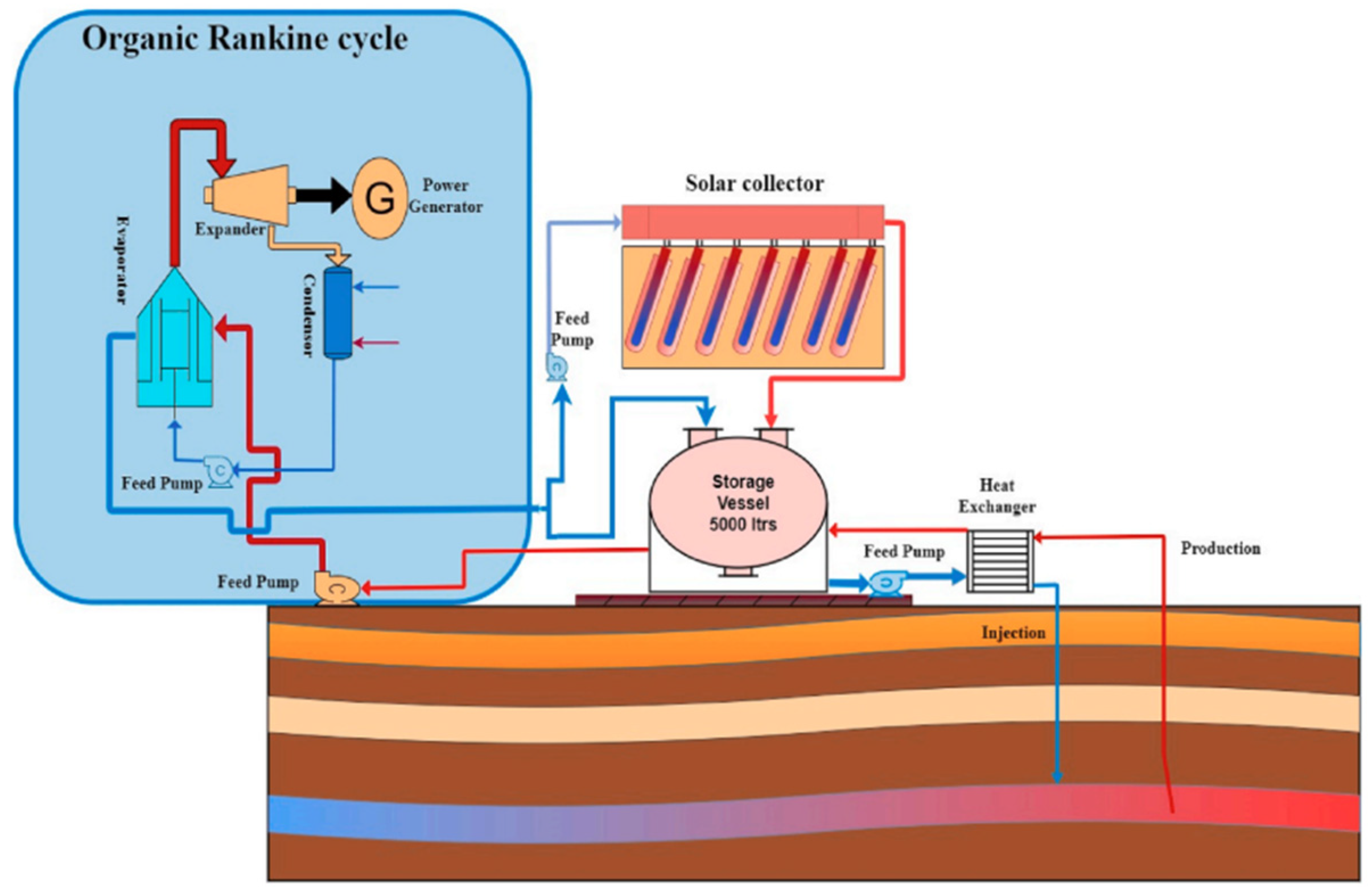
2.3. Heat Upgrade Configurations with Solar–Geothermal ORC
2.4. Other Configurations with Solar–Geothermal ORC
| Reference | ORC Types and Working Fluids | Geothermal Source Temperature | Solar Collector Type | Method of Hybridization | Results | |
|---|---|---|---|---|---|---|
| Hybrid Plant | Comparison with Individual Plant | |||||
| Acar and Arslan [42] | Subcritical BORC, R600a | 150 °C | - | Series | ηORC = 5.56–12.56%, ηex = 58.24–70.91%, E = 146,362–171,385 kWh | ηORC = −0.02–0.04% ηex = −2.76–5.92% E = +1.03–1.3% |
| Heberle et al. [43] | Subcritical RORC, n-butane | 170 °C | PTC | Series | - | E = +2.8–5.2 GWh/a |
| Song et al. [44] | Subcritical BORC, R245fa | 90 °C | - | Series with upgraded geothermal condenser | - | ηORC = +11.21% P = +184.13 kW |
| Maali and Khir [45,46] | Subcritical BORC and RORC, n-pentane | 55–70 °C | PTC | Series with geothermal preheater before recuperator | ηORC = 15.77% winter–13.11% summer, Pmax = 1089 kW winter–1882 kW summer | - |
| Li et al. [48] | Subcritical RORC, R245fa | 70–90 °C | PTC | Series | E = 1205–1319 MWh LCOE = 0.14–0.44 USD/kWh | Pmax = +25.34% Maximum LCOE decrease = −16.28% |
| Tempesti et al. [49,50] | Subcritical SSBORC and DSBORC, R245fa | 80–100 °C | PTC (SS)/ETC and PTC (DS) | For the single stage: Series For the double stage: Series, direct heating by ETCs and PTCs, vessel for separating the saturated vapor phase | ηORC,SS = 15.1%, ηex,SS = 25%, ηORC,DS = 12.7%, ηex,DS = 20% Cost = EUR 292,780–318,200. | - |
| Ruzzeneti et al. [51] | Subcritical BORC, R134a/R245fa/R236fa | 90–95 °C | ETC | Series | Climate change potential = 329.46–990.08 g(CO2)/kW he | - |
| Astolfi et al. [52] | Supercritical RORC, R134a | 150 °C | PTC | Series | ηsys = 8.5–9.4% LCOE = 0.145–0.280 USD/kWh | - |
| Cakici et al. [53] and Erdogan and Cakici [54] | Supercritical RORC, R134a, R124, R142b, R227ea, Isobutane | 100–250 °C | PTC | Series | ηORC = 21.63% ηex = 70.06% Pmax = 16.733 kW | - |
| Zhou et al. [55,56] | Subcritical and Supercritical BORC, Isopentane | 120–210 °C | PTC | Series | Subcritical ηORC = 8.70–11.59% ηex = 13.71–14.07% LCOE = 0.165–0.222 USD/kWh Supercritical ηORC = 9.43–10.80% ηex = 8.90–14.68% | LCOEsub = −23% |
| Ghasemi et al. [30] | Subcritical RORC, Isobutane | 145 °C | PTC | Parallel | - | P = +10–40% |
| Baral [60] | Subcritical BORC, R134a/R245fa | 70 °C | ETC | Parallel with TES | R134a: P = 25 kW Cost of energy = 0.17 USD/kWh PBP = 10.5 years R245fa: P = 30 kW Cost of energy = 0.14 USD/kWh PBP = 7.5 years | R134a: P = +43% R245fa: P = +33% |
| Bist and Sircar [59] | Subcritical BORC, R134a | 45 °C | ETC | Parallel with TES | P = 20–35 kW | - |
| Basseti et al. [62] | Subcritical BORC, Isobutane | 140–154.5 °C | PTC | Parallel with TES | - | E = +5.3–6.3% |
| Cirrincione et al. [63] | Subcritical BORC, R134a/Ammonia | 95 °C | ETC | Heat upgrade with backup boiler | ηORC = 12% Pmax = 200 kW | - |
| Djemaa et al. [64] | Subcritical BORC, R134a | 98 °C | PTC | Heat upgrade | ηORC = 16.1% P = 3823 kW. | - |
| Hu et al. [65,66] | Subcritical BORC, R1234z | 120 °C | PTC | Heat upgrade | Etotal = 339 GWh NPV = USD 10.2 million | - |
| Almehmadi et al. [67] | Subcritical BORC, R123/R113 | 75 °C | - | Heat upgrade | ηORC = 5–14% ηex = 27.3–52.5% LCOE = 0.118–0.171 USD/kW | - |
| Atiz et al. [68] | Subcritical BORC, n-butane | 67 °C/74 °C/86 °C | ETC | Heat upgrade | ηsys = 6.92% ηex,sys = 21.06% P = 19.46 kW | - |
| Atiz [69] | Subcritical BORC, n-butane | 93 °C | PTC/ETC/FPC | Heat upgrade | ηsys,PTC = 5.6% EPTC = 414.93 MJ ηsys,ETC = 3.79% EETC = 238.49 MJ ηsys,FPC = 1.76% EFPC = 95.45 MJ | - |
| Shoaei et al. [70] | Cascade system of five subsystems with two BORCs at the bottom, R123/Ammonia | 150 °C | PTC | Heat upgrade | ηsys = 50.59% ηex,sys = 25.44% Exd = 1537.35 kW P = 524.66 kW | - |
| Alibaba et al. [71] | Top: Steam Rankine Cycle Bottom: Subcritical RORC, R114 | 150 °C | PTC | PTC for topping, geothermal source for bottoming ORCs | - | LCOE = −2% |
| Boukelia et al. [72] | Top: Steam Rankine Cycle Bottom: Subcritical ORC, Ammonia | 65 °C | PTC | PTC for steam cycle, enhanced geothermal source for ORCs | Eyear = 22.20 GWhe ηsys = 14.67% LCOE = 0.104 USD/kWh | P = +19.36% |
| Cao et al. [73] | Top: Supercritical Brayton Cycle, CO2 Bottom: Subcritical BORC, R245ca | 180 °C | - | Solar source for Brayton Cycle, enhanced geothermal source for ORCs | ηsys = 35.07% P = 16.63 MW | - |
| Song et al. [74] | Top: Supercritical CO2 cycle Bottom: Subcritical BORC, R245fa | 150 °C | PTC | Series solar–geothermal for SORC, geothermal for ORCs | P = 2940 kW Eyear = 4540–5420 MWh | - |
| Al-Nimr et al. [76] | Subcritical BORC, R134a | - | CPVT | CPVT as heat source, geothermal condenser | ηORC,th = 4.3–12% ηORC,tot = 2.1–4.5% ηsys = 21.9–22.1% | - |
| Kara [77] | Subcritical RORC, Toluene/Cyclohexane/Isopentane | 14.8 °C/25.9 °C | PTC | Solar system with storage tank, geothermal condenser | ηORC,JAN = 30% ηORC,JUN = 28% | - |
| Pavlovic et al. [78] | Subcritical BORC, Toluene | 15–22 °C | Solar Dish Collectors | Solar system with storage tank, geothermal condenser | ηel = 21.54% ηORC = 35.99% | - |
3. Solar–Biomass ORC
3.1. Series Configurations with Solar–Biomass ORC
3.2. Parallel Configurations with Solar–Biomass ORC
3.3. Heat Upgrade Configurations with Solar–Biomass ORC
3.4. Other Configurations with Solar–Biomass ORC
| Reference | ORC Types and Working Fluids | Biomass Fuel | Solar Collector Type | Type of Hybridization | Results | |
|---|---|---|---|---|---|---|
| Hybrid | Comparison with Standalone Plant | |||||
| Calli et al. [80] | Subcritical BORC, R134a | Wheat straw/hazelnut shells/wood/paper | PTC | Series | ηsys = 8.8% ηex = 6.8% | |
| Middelhof et al. [81] | Subcritical BORC, Toluene | Mix of pine sawdust, hardwood sawdust, and nutshells | PTC | Series | Pel = 5 MWe Pth = 10 MWth ηORC,th = 37.57% ηORC,el = 18.79% ηel,only = 20.53% | - |
| Calli et al. [82] | Subcritical BORC, R245fa | Wood | PTC | Series | Electricity cost reduction = 30% | - |
| Pina et al. [83] | Subcritical RORC, R245fa | Commercial biomass pellets | PTC | Parallel with TES | Cost of electricity = 0.2030 EUR/kWh | Cost of electricity = +0.0572 EUR/kWh |
| Soares and Oliveira [84] | Subcritical RORC, Solvay SES36 (azeotropic mixture) | Biogas | PTC | Parallel | ηORC = 12.7% ηsys = 9.6% | ηORC = +33.7% ηsys = +182.3% |
| Ahmet and Mahanta [85] | Subcritical RORC, R123/R134a/R600a | Rice husk | PTC | Parallel | ηorc = 20.2%/13.0%/16.7% ηsys = 13.5%/8.7%/11.2% | ηsys = +11.5–12% |
| Zourellis et al. [86] | Subcritical ORC, Cyclopentane | Wood chips | PTC | Parallel | Pth = 16.6 MWth Eheat,annual = 16,000 MWh | - |
| Oyekale et al. [87,88,89,90,91] | Subcritical RORC, MM | Wood | LFC | Parallel | ηORC = 19.8% ηORC,ex = 11% LCOE = 0.130–0.146 EUR/kWh | - |
| Morrone et al. [94,95] | Transcritical RORC, Isobutane | - | PTC | Heat upgrade | Pel = 44 kW Pth = 168 kW ηORC,el = 17.6% ηORC,th = 67.2% PBP = 7.5 years Electrical energy cost = 97.7 EUR/MWhe Thermal energy cost = 46.5 EUR/MWhth. | - |
| Mouaky et al. [96] | Subcritical BORC, R245fa | Olive waste residues | CPC | Heat upgrade | ηORC = 8.41% E = 38.2–46.9 kWh | E = + 30.7–34.1 kWh |
| Sorn et al. [97] | Subcritical BORC, R245fa | Various | ETC | Heat upgrade | ηORC = 9–11% ηORC,ex = 50–55% LCOE = 0.098–0.241 USD/kWh | - |
| Morais et al. [98] | Subcritical RORC, Cyclohexane | Wood briquette | PTC | Heat upgrade | ηex = 20% IRR = 6% NPV = 2.25 106ꞏ$ | |
| Jradi and Riffat [99] | Subcritical RORC, HFE7100 | Wood pellets | ETC | Heat upgrade | ηORC,el = 8.49–10.83% ηORC,th = 61.23–75.96% | - |
| Baral et al. [101] | CSP plant and subcritical ORC, R123/R245fa/D4/MDM | Wood | PTC | Solar and biomass-powered topping CSP plant, bottoming biomass-powered ORC | ηCSP = 39.5% ηORC = 12% PBP = 8 years | - |
| Qi et al. [102] | Subcritical cascaded BORCs, R245fa | Biomass Pellets | PV/T | Interconnected cycles powered by one source each | P = 205 kW ηsys = 14.14% | - |
4. Solar–Waste Heat Recovery ORC
4.1. Series Configurations with Solar–Waste Heat Recovery ORC
4.2. Parallel Configurations with Solar–Waste Heat Recovery ORC
4.3. Heat Upgrade Configurations with Solar–Waste Heat ORC
4.4. Other Configurations with Solar–Waste Heat ORC
| Reference | ORC Types and Working Fluids | Waste Heat Source Temperature | Solar Collector Type | Type of Hybridization | Results | |
|---|---|---|---|---|---|---|
| Hybrid | Comparison with Standalone Plant | |||||
| Bellos and Tzivanidis [25] | Subcritical RORC, Cyclohexane, MDM, n-pentane, toluene | 150–300 °C | PTC | Series | Pel = 479 kW–845 kW ηsys = 11.6–19.7% | |
| Zhang et al. [106] | Subcritical BORC, Hexane | 150 °C | PTC | Series | P = 80.75 kW PBP = 2.88 years | - |
| Chen et al. [105] | Subcritical BORC, Toluene, MM, MDM | >150 °C | LFC | Series | TACtoluene = USD 1,363,463 TACMM = USD 1,439,427 TACMDM = USD 1,425,128 | TACtoluene = −5.71% TACMM = −6.99% TACMDM = −10.97% |
| Liang et al. [107] | Multi-pressure ORC, n-pentane/n-heptane (0.9/0.1) | 190 °C | PTC | Parallel with the storage tank | P = 428.91 kW–475.55 kW ηsys = 12.09–13.47% | - |
| Orumiyehei et al. [108] | Subcritical RORC, Toluene | 100–750 °C | LFC | Parallel with steam accumulators | ηsys = 12.3% ηsys,ex = 16.35% ηORC = 17.4% ηORC,ex = 53% | ηsys = −26.5% ηsys,ex = −39.7% ηORC = +0% ηORC,ex = +10% |
| Dokl et al. [103] | Subcritical ORC with Splitter and Two Evaporators, R245fa/R1234yf/R1234ze | 80 °C | ETC | Parallel | P = 979.8 kW | - |
| Gomaa et al. [110] | Subcritical BORC, R245fa | 250–280 °C | PTC | Heat upgrade | ηORC = 16.7% ηsys = 15.6% P = 323 kW–360 kW | - |
| Sonsaree et al. [109] | Subcritical BORC, R245fa | 60 °C | - | Heat upgrade with VCHP | E = 47.0 MWh/year LCOE = 0.098 USD/kWh PBP = 22.5 years | - |
| Wang et al. [100] | Subcritical BORC, Toluene | - | PTC | Heat upgrade | ηsys,ex = 22.98% | - |
| Al-Hawari et al. [111] | Double-Pressure ORC, R123 | - | FPC | Solar collector for LP fluid, exhaust gas for HP fluid | ηex = 23.93% Total Cost Rate = 3.84 USD/h | - |
5. Waste or Biomass–Geothermal ORC
6. Discussion
6.1. Main Findings
6.2. Limitations
6.3. Future Work
7. Conclusions
- -
- The arrangements of the combined heat sources were categorized into the following three main configurations: series, parallel, and heat upgrade. There were also a few studies of other heat source arrangements not falling into these categories, highlighting the numerous possibilities for renewable and alternative source combinations for power production.
- -
- Solar energy was the most combined source, with PTCs being the main solar technology integrated into hybrid ORC systems. The literature lacks systems that combine the other three sources with each other.
- -
- In solar–geothermal ORC plants, the utilization of low-temperature geothermal sources (<100 °C) is favored. The combination with solar energy helps to mitigate the problem of high ambient temperatures, which can decrease the plant efficiency, by using the solar contribution to further increase the temperature of the heat source fluid. The average LCOE reported for this case was 0.165 USD/kWh.
- -
- Solar–biomass ORC plants exhibited the lowest average LCOE of 0.153 USD/kWh among the examined source combinations. The lowest reported LCOE across all of the cases was for such a system, with a value of 0.098 USD/kWh. These plants were preferred for applications requiring heat of a higher grade and for combined heat and power production.
- -
- Solar–waste ORCs presented similar advantages as the previously mentioned combinations, but they are studied less frequently so far. The lowest reported plant payback period concerned these systems, with a value of 2.88 years. An LCOE of around 0.10 USD/kWh was reported for these systems based on limited studies.
- -
- Other combinations of geothermal energy, biomass, and waste heat in ORC applications were very limited due to the challenge of finding two of these sources in the same region.
- -
- The reported payback periods were in a range of 2.88 years to 10.5 years, with solar–geothermal and solar–biomass plants consistently falling between 7.5 and 10.5 years, while the lowest value was reported for a solar–waste plant.
- -
- The series configuration presented a better thermodynamic performance, while the heat upgrade presented greater power production. Working media with a low critical temperature were more compatible with the parallel configurations.
- -
- Overall, hybrid systems demonstrated better thermodynamic performance compared to ORC systems driven by one source, with an increase in the power generation of up to 44%.
- -
- More studies on ORC systems combining geothermal energy, biomass, and waste could be conducted, as well as investigations into ORC plants integrating more than two heat sources.
- -
- A comparative analysis of the performance of the three source arrangements—series, parallel, and heat upgrade—could help to identify the conditions that fit in each configuration.
- -
- An exploration of hybrid ORCs in polygeneration systems, such as waste heat utilization for heating, cooling, distillation, etc.
- -
- The incorporation of zeotropic mixtures as working media in hybrid units for better heat source utilization due to their temperature glide during evaporation.
- -
- Conducting experimental studies to validate the theoretical advancements, and to provide data on the system performance and real-world feasibility of ORC systems with combined heat sources.
Author Contributions
Funding
Data Availability Statement
Conflicts of Interest
Nomenclature
| A | Collector area, m2 |
| cp,s | Specific heat capacity of the heat source fluid, kJ/kg |
| Exs | Source exergy, kW |
| Enet | Net electrical energy, kWh |
| GT | Solar irradiance, W/m2 |
| morc | Mass flow rate, kg/s |
| h | Specific enthalpy, kJ/kg |
| Pgen | Electrical production by the generator, kW |
| Pnet | Net electrical power production, kW |
| Ppump | Pump power consumption, kW |
| Qout | Heat rejected in the condenser, kW |
| Qrec | Heat exchanged in the recuperator, kW |
| Qs | Total heat of the source, kW |
| Qu | Useful heat input to the system, kW |
| s | Specific entropy, kJ/kg |
| T | Temperature, °C |
| Wexp | Expander work production, kW |
| Wpump | Pump work consumption, kW |
| Greek symbols | |
| β | Ratio of the chemical exergy to the LHV of the organic fraction of biomass, - |
| ηgen | Generator efficiency, % |
| ηis | Isentropic efficiency, % |
| ηORC | Organic Rankine Cycle efficiency, % |
| ηsys | Overall system efficiency, % |
| ηth | Thermal efficiency, % |
| Subscripts and superscripts | |
| Bio | Biomass |
| Exp | Expander |
| Gen | Generator |
| Geo | Geothermal energy |
| Rec | Recuperator |
| Ref | Reference |
| Sol | Solar energy |
| WH | Waste heat |
| Abbreviations | |
| BORC | Basic Organic Rankine Cycle |
| CPVT | Concentrated photovoltaic/thermal |
| CHPCSP | Combined heat and powerConcentrating solar power |
| CPC | Compound parabolic collector |
| ETC | Evacuated tube collector |
| FPC | Flat plate collector |
| HRS | Heat recovery system |
| HTF | Heat transfer fluid |
| LCOE | Levelized cost of energy |
| LFC | Linear Fresnel collector |
| NPV | Net present value |
| ORC | Organic Rankine Cycle |
| PBP | Payback period |
| PTC | Parabolic trough collector |
| RORC | Recuperated organic Rankine Cycle |
| TES | Thermal energy storage |
References
- Sood, K.; Grima, S.; Young, P.; Ozen, E.; Balusamy, B. (Eds.) The Impact of Climate Change and Sustainability Standards on the Insurance Market, 1st ed.; Wiley: Hoboken, NJ, USA, 2023. [Google Scholar] [CrossRef]
- The Global Energy Crisis—World Energy Outlook 2022—Analysis. IEA. Available online: https://www.iea.org/reports/world-energy-outlook-2022/the-global-energy-crisis (accessed on 3 January 2025).
- World Energy Outlook 2023—Analysis. IEA. Available online: https://www.iea.org/reports/world-energy-outlook-2023 (accessed on 9 September 2024).
- World Energy Transitions Outlook 2023. Available online: https://www.irena.org/Digital-Report/World-Energy-Transitions-Outlook-2023?utm_source=chatgpt.com (accessed on 3 January 2025).
- Renewables 2023 Global Status Report. Available online: https://www.ren21.net/gsr-2023/ (accessed on 9 September 2024).
- “IRENA_World_energy_transitions_outlook_2024.pdf.”. Available online: https://www.irena.org/-/media/Files/IRENA/Agency/Publication/2024/Nov/IRENA_World_energy_transitions_outlook_2024.pdf (accessed on 3 January 2025).
- Bo, Z.; Zhang, K.; Sun, P.; Lv, X.; Weng, Y. Performance analysis of cogeneration systems based on micro gas turbine (MGT), organic Rankine cycle and ejector refrigeration cycle. Front. Energy 2019, 13, 54–63. [Google Scholar] [CrossRef]
- Zhang, X.; Zhang, T.; Xue, X.; Si, Y.; Zhang, X.; Mei, S. A comparative thermodynamic analysis of Kalina and organic Rankine cycles for hot dry rock: A prospect study in the Gonghe Basin. Front. Energy 2020, 14, 889–900. [Google Scholar] [CrossRef]
- Liu, Z.; He, T. Exergoeconomic analysis and optimization of a Gas Turbine-Modular Helium Reactor with new organic Rankine cycle for efficient design and operation. Energy Convers. Manag. 2020, 204, 112311. [Google Scholar] [CrossRef]
- Tartière, T.; Astolfi, M. A World Overview of the Organic Rankine Cycle Market. Energy Procedia 2017, 129, 2–9. [Google Scholar] [CrossRef]
- Thurairaja, K.; Wijewardane, A.; Jayasekara, S.; Ranasinghe, C. Working Fluid Selection and Performance Evaluation of ORC. Energy Procedia 2019, 156, 244–248. [Google Scholar] [CrossRef]
- Abas, N.; Kalair, A.R.; Khan, N.; Haider, A.; Saleem, Z.; Saleem, M.S. Natural and synthetic refrigerants, global warming: A review. Renew. Sustain. Energy Rev. 2018, 90, 557–569. [Google Scholar] [CrossRef]
- Liu, Q.; Duan, Y.; Yang, Z. Effect of condensation temperature glide on the performance of organic Rankine cycles with zeotropic mixture working fluids. Appl. Energy 2014, 115, 394–404. [Google Scholar] [CrossRef]
- Lecompte, S.; Huisseune, H.; Van Den Broek, M.; Vanslambrouck, B.; De Paepe, M. Review of organic Rankine cycle (ORC) architectures for waste heat recovery. Renew. Sustain. Energy Rev. 2015, 47, 448–461. [Google Scholar] [CrossRef]
- Braimakis, K.; Karellas, S. Exergetic optimization of double stage Organic Rankine Cycle (ORC). Energy 2018, 149, 296–313. [Google Scholar] [CrossRef]
- Bellos, E. A review of organic Rankine cycles with partial evaporation and dual-phase expansion. Sustain. Energy Technol. Assess. 2024, 72, 104059. [Google Scholar] [CrossRef]
- Zhou, Y.; Zhang, F.; Yu, L. Performance analysis of the partial evaporating organic Rankine cycle (PEORC) using zeotropic mixtures. Energy Convers. Manag. 2016, 129, 89–99. [Google Scholar] [CrossRef]
- Maraver, D.; Royo, J.; Lemort, V.; Quoilin, S. Systematic optimization of subcritical and transcritical organic Rankine cycles (ORCs) constrained by technical parameters in multiple applications. Appl. Energy 2014, 117, 11–29. [Google Scholar] [CrossRef]
- Wang, M.; Wang, J.; Zhao, Y.; Zhao, P.; Dai, Y. Thermodynamic analysis and optimization of a solar-driven regenerative organic Rankine cycle (ORC) based on flat-plate solar collectors. Appl. Therm. Eng. 2013, 50, 816–825. [Google Scholar] [CrossRef]
- Zhai, H.; Shi, L.; An, Q. Influence of working fluid properties on system performance and screen evaluation indicators for geothermal ORC (organic Rankine cycle) system. Energy 2014, 74, 2–11. [Google Scholar] [CrossRef]
- Al-Sulaiman, F.A.; Dincer, I.; Hamdullahpur, F. Energy and exergy analyses of a biomass trigeneration system using an organic Rankine cycle. Energy 2012, 45, 975–985. [Google Scholar] [CrossRef]
- Sprouse, C.; Depcik, C. Review of organic Rankine cycles for internal combustion engine exhaust waste heat recovery. Appl. Therm. Eng. 2013, 51, 711–722. [Google Scholar] [CrossRef]
- Zhang, H.G.; Wang, E.H.; Fan, B.Y. A performance analysis of a novel system of a dual loop bottoming organic Rankine cycle (ORC) with a light-duty diesel engine. Appl. Energy 2013, 102, 1504–1513. [Google Scholar] [CrossRef]
- Vittorini, D.; Cipollone, R.; Carapellucci, R. Enhanced performances of ORC-based units for low grade waste heat recovery via evaporator layout optimization. Energy Convers. Manag. 2019, 197, 111874. [Google Scholar] [CrossRef]
- Bellos, E.; Tzivanidis, C. Investigation of a hybrid ORC driven by waste heat and solar energy. Energy Convers. Manag. 2018, 156, 427–439. [Google Scholar] [CrossRef]
- Bellos, E.; Lykas, P.; Sammoutos, C.; Kitsopoulou, A.; Korres, D.; Tzivanidis, C. Thermodynamic investigation of a solar-driven organic Rankine cycle with partial evaporation. Energy Nexus 2023, 11, 100229. [Google Scholar] [CrossRef]
- Mikielewicz, D.; Wajs, J.; Ziółkowski, P.; Mikielewicz, J. Utilisation of waste heat from the power plant by use of the ORC aided with bleed steam and extra source of heat. Energy 2016, 97, 11–19. [Google Scholar] [CrossRef]
- Li, K.; Liu, C.; Jiang, S.; Chen, Y. Review on hybrid geothermal and solar power systems. J. Clean. Prod. 2020, 250, 119481. [Google Scholar] [CrossRef]
- Borsukiewicz-Gozdur, A. Exergy analysis for maximizing power of organic Rankine cycle power plant driven by open type energy source. Energy 2013, 62, 73–81. [Google Scholar] [CrossRef]
- Ghasemi, H.; Mitsos, A. A Hybrid Geothermal-Solar Power System: Optimal Design and Operation. In Proceedings of the ASME 2013 International Mechanical Engineering Congress and Exposition. Volume 6A: Energy, V06AT07A043. San Diego, CA, USA, 15–21 November 2013; American Society of Mechanical Engineers: San Diego, CA, USA, 2013. [Google Scholar] [CrossRef]
- Uusitalo, A.; Turunen-Saaresti, T.; Honkatukia, J.; Dhanasegaran, R. Experimental study of small scale and high expansion ratio ORC for recovering high temperature waste heat. Energy 2020, 208, 118321. [Google Scholar] [CrossRef]
- Blanco, J.M.; Peña, F. Increase in the boiler’s performance in terms of the acid dew point temperature: Environmental advantages of replacing fuels. Appl. Therm. Eng. 2008, 28, 777–784. [Google Scholar] [CrossRef]
- Ptasinski, K.J.; Prins, M.J.; Pierik, A. Exergetic evaluation of biomass gasification. Energy 2007, 32, 568–574. [Google Scholar] [CrossRef]
- Loni, R.; Mahian, O.; Markides, C.N.; Bellos, E.; le Roux, W.G.; Kasaeian, A.; Najafi, G.; Rajaee, F. A review of solar-driven organic Rankine cycles: Recent challenges and future outlook. Renew. Sustain. Energy Rev. 2021, 150, 111410. [Google Scholar] [CrossRef]
- Loni, R.; Najafi, G.; Bellos, E.; Rajaee, F.; Said, Z.; Mazlan, M. A review of industrial waste heat recovery system for power generation with Organic Rankine Cycle: Recent challenges and future outlook. J. Clean. Prod. 2021, 287, 125070. [Google Scholar] [CrossRef]
- Loni, R.; Mahian, O.; Najafi, G.; Sahin, A.Z.; Rajaee, F.; Kasaeian, A.; Mehrpooya, M.; Bellos, E.; le Roux, W.G. A critical review of power generation using geothermal-driven organic Rankine cycle. Therm. Sci. Eng. Prog. 2021, 25, 101028. [Google Scholar] [CrossRef]
- Ahmadi, A.; Assad, M.E.H.; Jamali, D.; Kumar, R.; Li, Z.; Salameh, T.; Al-Shabi, M.; Ehyaei, M. Applications of geothermal organic Rankine Cycle for electricity production. J. Clean. Prod. 2020, 274, 122950. [Google Scholar] [CrossRef]
- Heidarnejad, P.; Genceli, H.; Hashemian, N.; Asker, M.; Al-Rawi, M. Biomass-Fueled Organic Rankine Cycles: State of the Art and Future Trends. Energies 2024, 17, 3788. [Google Scholar] [CrossRef]
- Zhai, H.; An, Q.; Shi, L.; Lemort, V.; Quoilin, S. Categorization and analysis of heat sources for organic Rankine cycle systems. Renew. Sustain. Energy Rev. 2016, 64, 790–805. [Google Scholar] [CrossRef]
- Hettiarachchi, H.D.M.; Golubovic, M.; Worek, W.M.; Ikegami, Y. Optimum design criteria for an Organic Rankine cycle using low-temperature geothermal heat sources. Energy 2007, 32, 1698–1706. [Google Scholar] [CrossRef]
- Budisulistyo, D.; Wong, C.S.; Krumdieck, S. Lifetime design strategy for binary geothermal plants considering degradation of geothermal resource productivity. Energy Convers. Manag. 2017, 132, 1–13. [Google Scholar] [CrossRef]
- Acar, M.S.; Arslan, O. Energy and exergy analysis of solar energy-integrated, geothermal energy-powered Organic Rankine Cycle. J. Therm. Anal. Calorim. 2019, 137, 659–666. [Google Scholar] [CrossRef]
- Heberle, F.; Hofer, M.; Brüggemann, D. A Retrofit for Geothermal Organic Rankine Cycles based on Concentrated Solar Thermal Systems. Energy Procedia 2017, 129, 692–699. [Google Scholar] [CrossRef]
- Song, A.; Zhu, J.; Zhang, P.; Chang, N.; Cui, Z. Experimental Research on Solar and Geothermal Energy Coupling Power Generation System. Energy Procedia 2019, 158, 5982–5987. [Google Scholar] [CrossRef]
- Maali, R.; Khir, T. Performance analysis of different orc power plant configurations using solar and geothermal heat sources. Int. J. Green Energy 2020, 17, 349–362. [Google Scholar] [CrossRef]
- Maali, R.; Khir, T.; Arici, M. Energy and exergy optimization of a combined solar/geothermal organic Rankine cycle power plant. J. Cent. South Univ. 2023, 30, 3601–3616. [Google Scholar] [CrossRef]
- Maali, R.; Khir, T. Thermodynamic analysis and optimization of an ORC hybrid geothermal–solar power plant. Euro-Mediterr. J. Environ. Integr. 2023, 8, 341–352. [Google Scholar] [CrossRef]
- Li, D.; Rao, Z.; Zhuo, Q.; Chen, R.; Dong, X.; Liu, G.; Liao, S. Resource endowments effects on thermal-economic efficiency of ORC-based hybrid solar-geothermal system. Case Stud. Therm. Eng. 2023, 52, 103739. [Google Scholar] [CrossRef]
- Tempesti, D.; Manfrida, G.; Fiaschi, D. Thermodynamic analysis of two micro CHP systems operating with geothermal and solar energy. Appl. Energy 2012, 97, 609–617. [Google Scholar] [CrossRef]
- Tempesti, D.; Fiaschi, D. Thermo-economic assessment of a micro CHP system fuelled by geothermal and solar energy. Energy 2013, 58, 45–51. [Google Scholar] [CrossRef]
- Ruzzenenti, F.; Bravi, M.; Tempesti, D.; Salvatici, E.; Manfrida, G.; Basosi, R. Evaluation of the environmental sustainability of a micro CHP system fueled by low-temperature geothermal and solar energy. Energy Convers. Manag. 2014, 78, 611–616. [Google Scholar] [CrossRef]
- Astolfi, M.; Xodo, L.; Romano, M.C.; Macchi, E. Technical and economical analysis of a solar–geothermal hybrid plant based on an Organic Rankine Cycle. Geothermics 2011, 40, 58–68. [Google Scholar] [CrossRef]
- Cakici, D.M.; Erdogan, A.; Colpan, C.O. Thermodynamic performance assessment of an integrated geothermal powered supercritical regenerative organic Rankine cycle and parabolic trough solar collectors. Energy 2017, 120, 306–319. [Google Scholar] [CrossRef]
- Erdogan, A.; Cakici, D.M.; Colpan, C.O. Thermodynamic optimisation of a hybrid solar-geothermal power plant using Taguchi method. Int. J. Exergy 2017, 23, 63. [Google Scholar] [CrossRef]
- Zhou, C.; Doroodchi, E.; Moghtaderi, B. An in-depth assessment of hybrid solar–geothermal power generation. Energy Convers. Manag. 2013, 74, 88–101. [Google Scholar] [CrossRef]
- Zhou, C. Hybridisation of solar and geothermal energy in both subcritical and supercritical Organic Rankine Cycles. Energy Convers. Manag. 2014, 81, 72–82. [Google Scholar] [CrossRef]
- Ghasemi, H.; Sheu, E.; Tizzanini, A.; Paci, M.; Mitsos, A. Hybrid solar–geothermal power generation: Optimal retrofitting. Appl. Energy 2014, 131, 158–170. [Google Scholar] [CrossRef]
- Ayub, M.; Mitsos, A.; Ghasemi, H. Thermo-economic analysis of a hybrid solar-binary geothermal power plant. Energy 2015, 87, 326–335. [Google Scholar] [CrossRef]
- Bist, N.; Sircar, A. Hybrid solar geothermal setup by optimal retrofitting. Case Stud. Therm. Eng. 2021, 28, 101529. [Google Scholar] [CrossRef]
- Baral, S. Experimental and Techno-Economic Analysis of Solar-Geothermal Organic Rankine Cycle Technology for Power Generation in Nepal. Int. J. Photoenergy 2019, 2019, 1–15. [Google Scholar] [CrossRef]
- Calise, F.; Cappiello, F.L.; Dentice d’Accadia, M.; Vicidomini, M. Energy and economic analysis of a small hybrid solar-geothermal trigeneration system: A dynamic approach. Energy 2020, 208, 118295. [Google Scholar] [CrossRef]
- Bassetti, M.C.; Consoli, D.; Manente, G.; Lazzaretto, A. Design and off-design models of a hybrid geothermal-solar power plant enhanced by a thermal storage. Renew. Energy 2018, 128, 460–472. [Google Scholar] [CrossRef]
- Cirrincione, L.; Morale, M.; Peri, G.; Scaccianoce, G. Development of sustainable ORC applications in the tertiary sector: A case study in the Mediterranean climate. IOP Conf. Ser. Earth Environ. Sci. 2022, 1106, 012016. [Google Scholar] [CrossRef]
- Djemaa, A.; Merabet, A.; Rebhi, R.; Lorenzini, G.; Bessaih, R.; Menni, Y. Simulations and Optimizations for a Low-Temperature Hybrid Geothermal-Solar Power Plant. J. Adv. Res. Fluid Mech. Therm. Sci. 2022, 90, 109–123. [Google Scholar] [CrossRef]
- Hu, S.; Yang, Z.; Li, J.; Duan, Y. Thermo-economic optimization of the hybrid geothermal-solar power system: A data-driven method based on lifetime off-design operation. Energy Convers. Manag. 2021, 229, 113738. [Google Scholar] [CrossRef]
- Hu, S.; Yang, Z.; Li, J.; Duan, Y. Optimal solar thermal retrofit for geothermal power systems considering the lifetime brine degradation. Renew. Energy 2022, 186, 628–645. [Google Scholar] [CrossRef]
- Almehmadi, F.A.; Najib, A.; Ali, E.; Alqaed, S.; Mustafa, J.; Al-Ansary, H. Thermodynamic optimization of hybrid solar-geothermal power plant coupled with DCMD for water and electricity production: A Case study at Ain Khulab, Saudi Arabia. Energy Rep. 2023, 10, 3240–3251. [Google Scholar] [CrossRef]
- Atiz, A.; Karakilcik, H.; Erden, M.; Karakilcik, M. Investigation energy, exergy and electricity production performance of an integrated system based on a low-temperature geothermal resource and solar energy. Energy Convers. Manag. 2019, 195, 798–809. [Google Scholar] [CrossRef]
- Atiz, A. Comparison of three different solar collectors integrated with geothermal source for electricity and hydrogen production. Int. J. Hydrogen Energy 2020, 45, 31651–31666. [Google Scholar] [CrossRef]
- Shoaei, M.; Hajinezhad, A.; Moosavian, S.F. Design, energy, exergy, economy, and environment (4E) analysis, and multi-objective optimization of a novel integrated energy system based on solar and geothermal resources. Energy 2023, 280, 128162. [Google Scholar] [CrossRef]
- Alibaba, M.; Pourdarbani, R.; Manesh, M.H.K.; Herrera-Miranda, I.; Gallardo-Bernal, I.; Hernández-Hernández, J.L. Conventional and Advanced Exergy-Based Analysis of Hybrid Geothermal–Solar Power Plant Based on ORC Cycle. Appl. Sci. 2020, 10, 5206. [Google Scholar] [CrossRef]
- Boukelia, T.E.; Arslan, O.; Djimli, S.; Kabar, Y. ORC fluids selection for a bottoming binary geothermal power plant integrated with a CSP plant. Energy 2023, 265, 126186. [Google Scholar] [CrossRef]
- Cao, Y.; Li, P.; Qiao, Z.; Ren, S.; Si, F. A concept of a supercritical CO2 Brayton and organic Rankine combined cycle for solar energy utilization with typical geothermal as auxiliary heat source: Thermodynamic analysis and optimization. Energy Rep. 2022, 8, 322–333. [Google Scholar] [CrossRef]
- Song, J.; Wang, Y.; Wang, K.; Wang, J.; Markides, C.N. Combined supercritical CO2 (SCO2) cycle and organic Rankine cycle (ORC) system for hybrid solar and geothermal power generation: Thermoeconomic assessment of various configurations. Renew. Energy 2021, 174, 1020–1035. [Google Scholar] [CrossRef]
- Ayadi, B.; Jasim, D.J.; Anqi, A.E.; Aich, W.; Rajhi, W.; Marefati, M. Multi-criteria/comparative analysis and multi-objective optimization of a hybrid solar/geothermal source system integrated with a carnot battery. Case Stud. Therm. Eng. 2024, 54, 104031. [Google Scholar] [CrossRef]
- Al-Nimr, M.A.; Bukhari, M.; Mansour, M. A combined CPV/T and ORC solar power generation system integrated with geothermal cooling and electrolyser/fuel cell storage unit. Energy 2017, 133, 513–524. [Google Scholar] [CrossRef]
- Kara, O. An Evaluation of a New Solar-Assisted and Ground-Cooled Organic Rankine Cycle (ORC) with a Recuperator. Arab. J. Sci. Eng. 2023, 48, 11781–11800. [Google Scholar] [CrossRef]
- Pavlović, S.; Bellos, E.; Grozdanović, M. Numerical Investigation of a Solar-Driven Organic Rankine Cycle Coupled to a Geothermal Field. FU Work. Liv. Environ. Prot. 2021, 18, 87–102. [Google Scholar] [CrossRef]
- Jensen, A.R.; Sifnaios, I.; Perers, B.; Holst Rothmann, J.; Mørch, S.D.; Jensen, P.V.; Dragsted, J.; Furbo, S. Demonstration of a Concentrated Solar Power and Biomass Plant for Combined Heat and Power. Energy Convers. Manag. 2022, 271, 116207. [Google Scholar] [CrossRef]
- Calli, O.; Colpan, C.O.; Gunerhan, H. Energy, exergy and exergy and thermoeconomic analyses of biomass and solar powered organic Rankine cycles. Int. J. Exergy 2019, 29, 172. [Google Scholar] [CrossRef]
- Middelhoff, E.; Furtado, L.A.; Parise, J.A.R.; Ximenes, F.; Florin, N. Hybrid concentrated solar biomass (HCSB) systems for cogeneration: Techno-economic analysis for beef abattoirs in New South Wales, Australia. Energy Convers. Manag. 2022, 262, 115620. [Google Scholar] [CrossRef]
- Calli, O.; Colpan, C.O.; Gunerhan, H. Thermoeconomic analysis of a biomass and solar energy based organic Rankine cycle system under part load behavior. Sustain. Energy Technol. Assess. 2021, 46, 101207. [Google Scholar] [CrossRef]
- Pina, E.A.; Serra, L.M.; Lozano, M.A.; Hernández, A.; Lázaro, A. Comparative Analysis and Design of a Solar-Based Parabolic Trough–ORC Cogeneration Plant for a Commercial Center. Energies 2020, 13, 4807. [Google Scholar] [CrossRef]
- Soares, J.; Oliveira, A.C. Numerical simulation of a hybrid concentrated solar power/biomass mini power plant. Appl. Therm. Eng. 2017, 111, 1378–1386. [Google Scholar] [CrossRef]
- Ahmed, Z.; Mahanta, D.K. Thermodynamics analysis of hybrid solar-biomass power generation system. AIP Conf. Proc. 2019, 2091, 020003. [Google Scholar] [CrossRef]
- Zourellis, A.; Perers, B.; Donneborg, J.; Matoricz, J. Optimizing Efficiency of Biomass—Fired Organic Rankine Cycle with Concentrated Solar Power in Denmark. Energy Procedia 2018, 149, 420–426. [Google Scholar] [CrossRef]
- Oyekale, J.; Heberle, F.; Petrollese, M.; Brüggemann, D.; Cau, G. Biomass retrofit for existing solar organic Rankine cycle power plants: Conceptual hybridization strategy and techno-economic assessment. Energy Convers. Manag. 2019, 196, 831–845. [Google Scholar] [CrossRef]
- Oyekale, J.; Petrollese, M.; Cau, G. Multi-objective thermo-economic optimization of biomass retrofit for an existing solar organic Rankine cycle power plant based on NSGA-II. Energy Rep. 2020, 6, 136–145. [Google Scholar] [CrossRef]
- Oyekale, J.; Petrollese, M.; Heberle, F.; Brüggemann, D.; Cau, G. Exergetic and integrated exergoeconomic assessments of a hybrid solar-biomass organic Rankine cycle cogeneration plant. Energy Convers. Manag. 2020, 215, 112905. [Google Scholar] [CrossRef]
- Oyekale, J.; Petrollese, M.; Cau, G. Modified auxiliary exergy costing in advanced exergoeconomic analysis applied to a hybrid solar-biomass organic Rankine cycle plant. Appl. Energy 2020, 268, 114888. [Google Scholar] [CrossRef]
- Oyekale, J.; Petrollese, M.; Cocco, D.; Cau, G. Annualized exergoenvironmental comparison of solar-only and hybrid solar-biomass heat interactions with an organic Rankine cycle power plant. Energy Convers. Manag. X 2022, 15, 100229. [Google Scholar] [CrossRef]
- Oyekale, J.; Heberle, F.; Petrollese, M.; Brüggemann, D.; Cau, G. Thermo-economic evaluation of actively selected siloxane mixtures in a hybrid solar-biomass organic Rankine cycle power plant. Appl. Therm. Eng. 2020, 165, 114607. [Google Scholar] [CrossRef]
- Oyekale, J.; Oreko, B. Effects of working fluid mixtures on the exergetic sustainability of a solar-biomass organic Rankine cycle power plant. Therm. Sci. Eng. Prog. 2022, 36, 101529. [Google Scholar] [CrossRef]
- Morrone, P.; Algieri, A.; Castiglione, T. Hybridisation of biomass and concentrated solar power systems in transcritical organic Rankine cycles: A micro combined heat and power application. Energy Convers. Manag. 2019, 180, 757–768. [Google Scholar] [CrossRef]
- Algieri, A.; Morrone, P. Thermo-economic investigation of solar-biomass hybrid cogeneration systems based on small-scale transcritical organic Rankine cycles. Appl. Therm. Eng. 2022, 210, 118312. [Google Scholar] [CrossRef]
- Mouaky, A.; Bennouna, E.G.; Rachek, A.; Bouhraichi, B.; Lembarki, N.; Idaghdour, O. Performance analysis of a hybrid solar/biomass power plant for different operating scenarios. AIP Conf. Proc. 2019, 2126, 090005. [Google Scholar] [CrossRef]
- Sorn, K.; Deethayat, T.; Asanakham, A.; Vorayos, N.; Kiatsiriroat, T. Subcooling effect in steam heat source on irreversibility reduction during supplying heat to an organic Rankine cycle having a solar-assisted biomass boiler. Energy 2020, 194, 116770. [Google Scholar] [CrossRef]
- Morais, P.H.D.S.; Lodi, A.; Aoki, A.C.; Energy, M.M. Exergetic and economic analyses of a combined solar-biomass-ORC cooling cogeneration systems for a Brazilian small plant. Renew. Energy 2020, 157, 1131–1147. [Google Scholar] [CrossRef]
- Jradi, M.; Riffat, S. Modelling and testing of a hybrid solar-biomass ORC-based micro-CHP system: Hybrid Solar-Biomass ORC-Based Micro CHP. Int. J. Energy Res. 2014, 38, 1039–1052. [Google Scholar] [CrossRef]
- Wang, L.; Yang, J.; Qu, B.; Pang, C. Multi-Objective Optimization of an Organic Rankine Cycle (ORC) for a Hybrid Solar–Waste Energy Plant. Energies 2024, 17, 1810. [Google Scholar] [CrossRef]
- Baral, S. Thermodynamic and financial assessment of concentrated solar power plant hybridized with biomass-based organic Rankine cycle, thermal energy storage, hot springs and CO2 capture systems. Int. J. Low-Carbon Technol. 2021, 16, 361–375. [Google Scholar] [CrossRef]
- Qi, X.; Yang, C.; Huang, M.; Ma, Z.; Hnydiuk-Stefan, A.; Feng, K.; Siarry, P.; Królczyk, G.; Li, Z. Conventional and advanced exergy-exergoeconomic-exergoenvironmental analyses of an organic Rankine cycle integrated with solar and biomass energy sources. Energy 2024, 288, 129657. [Google Scholar] [CrossRef]
- Dokl, M.; Kravanja, Z.; Čuček, L. Techno-Economic Optimization of a Low-Temperature Organic Rankine System Driven by Multiple Heat Sources. Front. Sustain. 2022, 3, 889258. [Google Scholar] [CrossRef]
- Behzadi, A.; Arabkoohsar, A.; Perić, V.S. Innovative hybrid solar-waste designs for cogeneration of heat and power, an effort for achieving maximum efficiency and renewable integration. Appl. Therm. Eng. 2021, 190, 116824. [Google Scholar] [CrossRef]
- Chen, H.; Zhao, L.; Cong, H.; Li, X. Synthesis of waste heat recovery using solar organic Rankine cycle in the separation of benzene/toluene/p-xylene process. Energy 2022, 255, 124443. [Google Scholar] [CrossRef]
- Zhang, S.; Liu, X.; Liu, L.; Pan, X.; Li, Q.; Wang, S.; Jiao, Y.; He, C.; Li, G. Thermo-economic assessment and multi-objective optimization of organic Rankine cycle driven by solar energy and waste heat. Energy 2024, 290, 130223. [Google Scholar] [CrossRef]
- Liang, Z.; Liang, Y.; Luo, X.; Chen, J.; Yang, Z.; Wang, C.; Chen, Y. Synthesis and simultaneous optimization of multi-heat source multi-pressure evaporation organic Rankine cycle with mixed working fluid. Energy Convers. Manag. 2022, 251, 114930. [Google Scholar] [CrossRef]
- Orumiyehei, A.; Ameri, M.; Nobakhti, M.H.; Zareh, M.; Edalati, S. Transient simulation of hybridized system: Waste heat recovery system integrated to ORC and Linear Fresnel collectors from energy and exergy viewpoint. Renew. Energy 2022, 185, 172–186. [Google Scholar] [CrossRef]
- Sonsaree, S.; Jiajitsawat, S.; Asaoka, T.; Aguirre, H.; Tanaka, K. Organic Rankine Cycle power generation from industrial waste heat recovery integrated with solar hot water system by using vapor compression heat pump as heating booster in Thailand. In Proceedings of the 2016 International Conference on Cogeneration, Small Power Plants and District Energy (ICUE), Bangkok, Thailand, 14–16 September 2016; IEEE: Piscataway, NJ, USA, 2016; pp. 1–6. [Google Scholar] [CrossRef]
- Gomaa, M.R.; Mustafa, R.J.; Al-Dhaifallah, M.; Rezk, H. A low-grade heat Organic Rankine Cycle driven by hybrid solar collectors and a waste heat recovery system. Energy Rep. 2020, 6, 3425–3445. [Google Scholar] [CrossRef]
- Al-Hawary, S.I.S.; Alvarez, J.R.N.; Ali, A.; Tripathi, A.K.; Rahardja, U.; Al-Kharsan, I.H.; Romero-Parra, R.M.; Marhoon, H.A.; John, V.; Hussian, W. Multiobjective optimization of a hybrid electricity generation system based on waste energy of internal combustion engine and solar system for sustainable environment. Chemosphere 2023, 336, 139269. [Google Scholar] [CrossRef] [PubMed]
- Briola, S.; Gabbrielli, R.; Bischi, A. Off-design performance analysis of a novel hybrid binary geothermal-biomass power plant in extreme environmental conditions. Energy Convers. Manag. 2019, 195, 210–225. [Google Scholar] [CrossRef]
- Mahmoud, M.; Naher, S.; Ramadan, M.; Abdelkareem, M.A.; Jaber, H.; Olabi, A.-G. Investigation of a ground-cooled organic Rankine cycle for waste heat recovery. Int. J. Thermofluids 2023, 18, 100348. [Google Scholar] [CrossRef]
- Özcan, Z.; Ekici, Ö. A novel working fluid selection and waste heat recovery by an exergoeconomic approach for a geothermally sourced ORC system. Geothermics 2021, 95, 102151. [Google Scholar] [CrossRef]
- Toselli, D.; Heberle, F.; Brüggemann, D. Techno-Economic Analysis of Hybrid Binary Cycles with Geothermal Energy and Biogas Waste Heat Recovery. Energies 2019, 12, 1969. [Google Scholar] [CrossRef]
- Köse, Ö.; Koç, Y.; Yağlı, H. Performance improvement of the bottoming steam Rankine cycle (SRC) and organic Rankine cycle (ORC) systems for a triple combined system using gas turbine (GT) as topping cycle. Energy Convers. Manag. 2020, 211, 112745. [Google Scholar] [CrossRef]
- Blanco, E.E.; Ochoa, G.V.; Thermodynamic, J.D.F. Exergy and Environmental Impact Assessment of S-CO2 Brayton Cycle Coupled with ORC as Bottoming Cycle. Energies 2020, 13, 2259. [Google Scholar] [CrossRef]
- Sadeghi, M.; Nemati, A.; Ghavimi, A.; Yari, M. Thermodynamic analysis and multi-objective optimization of various ORC (organic Rankine cycle) configurations using zeotropic mixtures. Energy 2016, 109, 791–802. [Google Scholar] [CrossRef]
- Miao, Z.; Zhang, K.; Wang, M.; Xu, J. Thermodynamic selection criteria of zeotropic mixtures for subcritical organic Rankine cycle. Energy 2019, 167, 484–497. [Google Scholar] [CrossRef]
- Chys, M.; Van Den Broek, M.; Vanslambrouck, B.; De Paepe, M. Potential of zeotropic mixtures as working fluids in organic Rankine cycles. Energy 2012, 44, 623–632. [Google Scholar] [CrossRef]

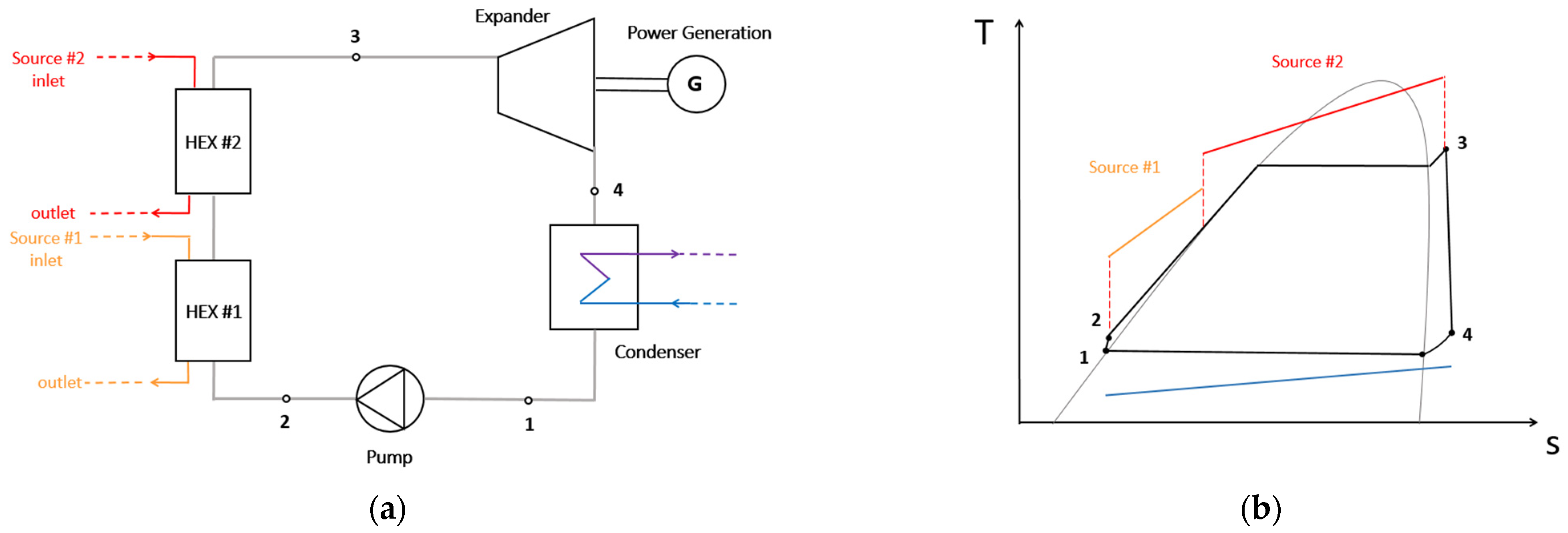

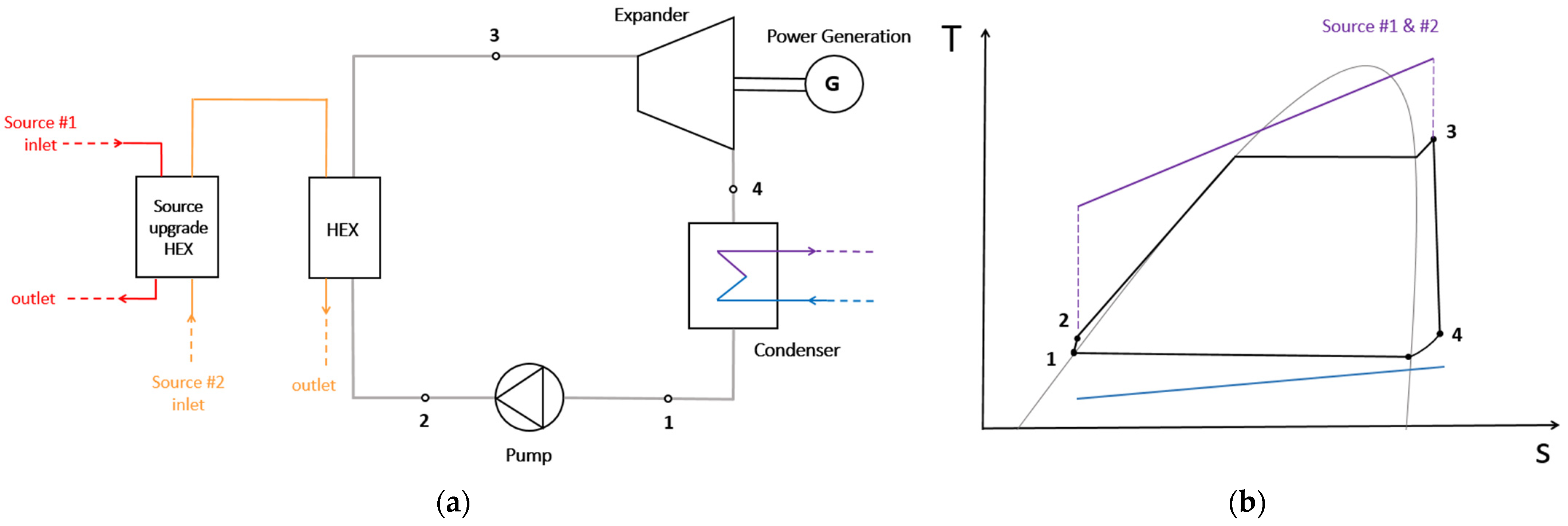
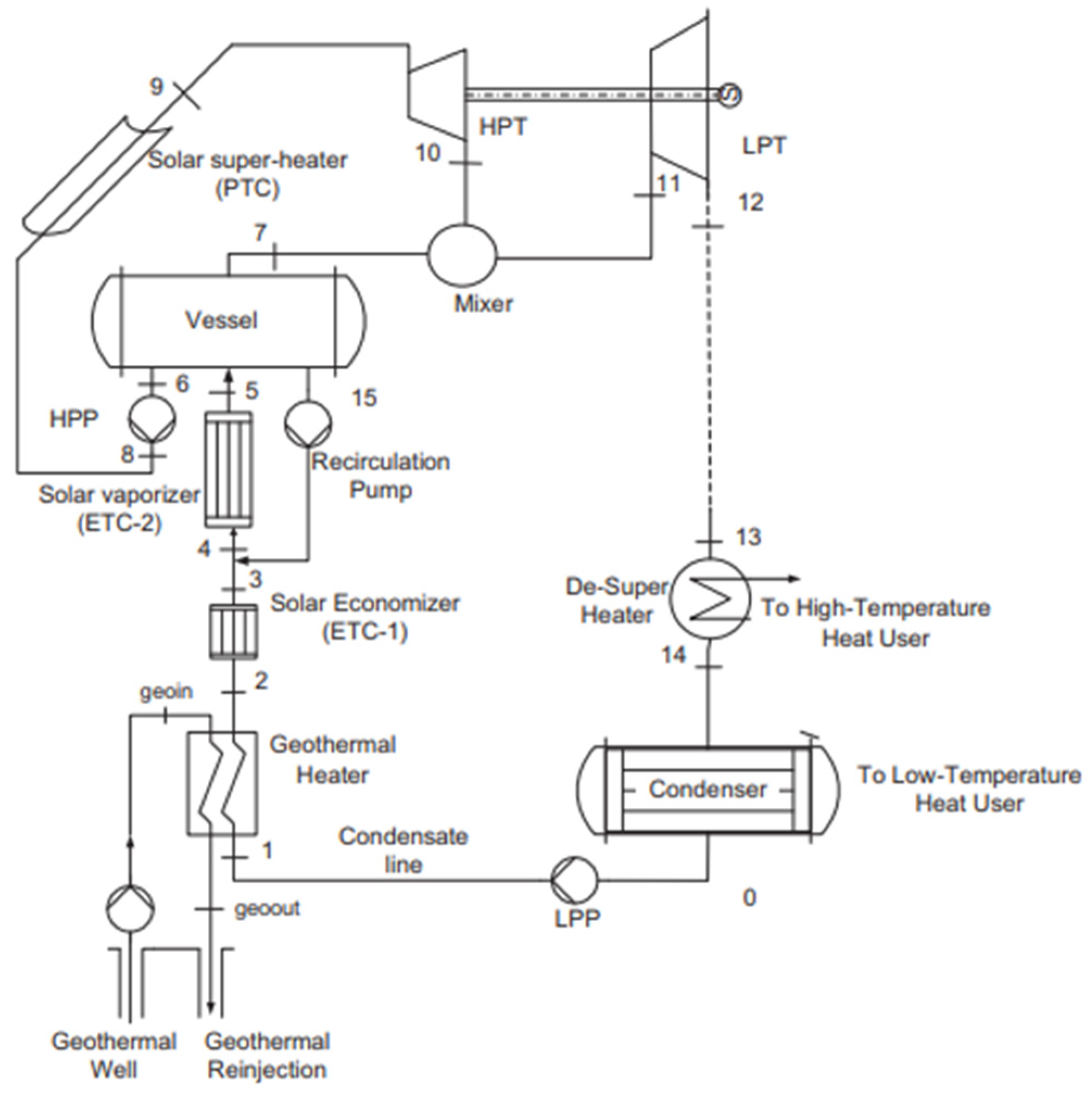
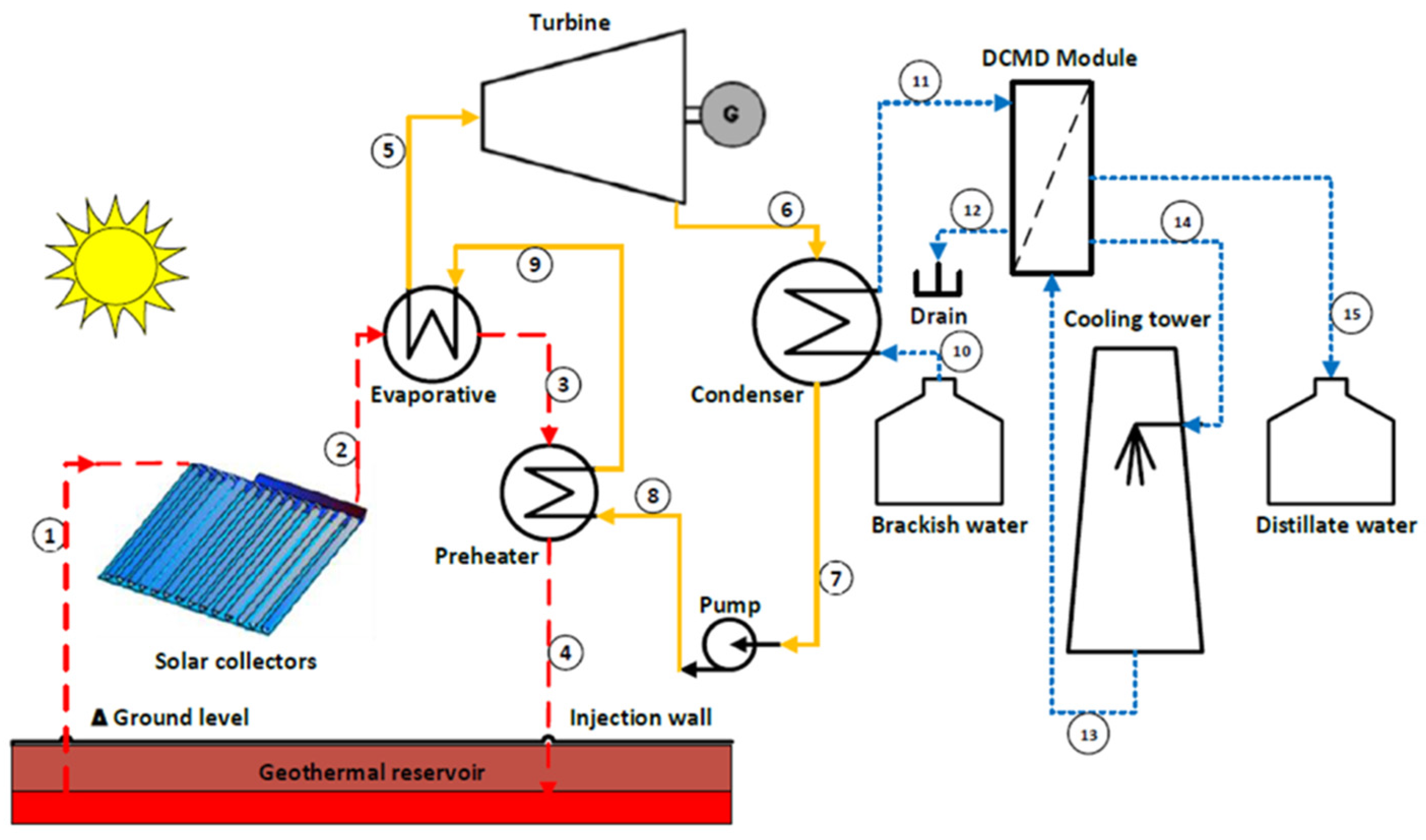
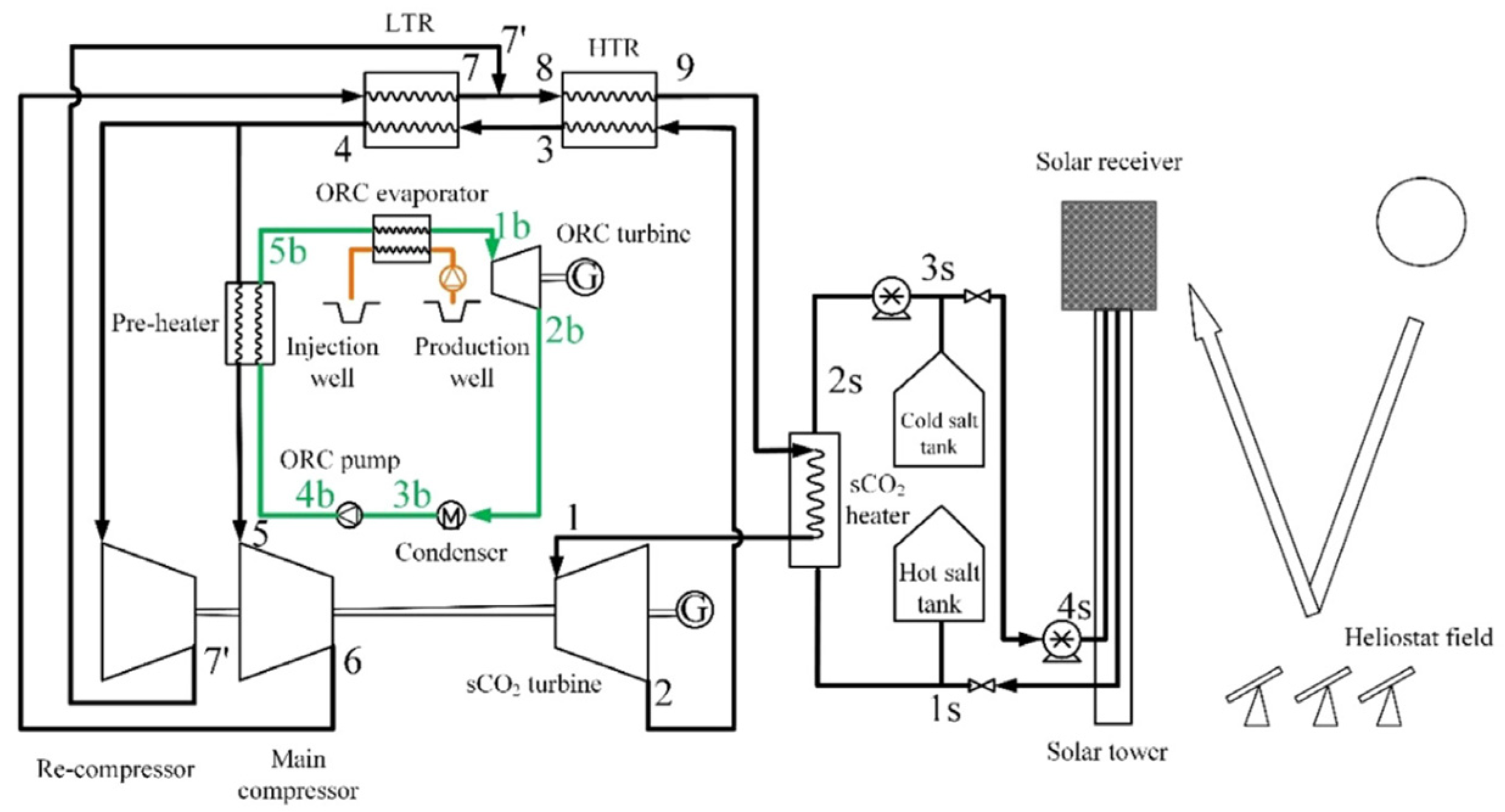
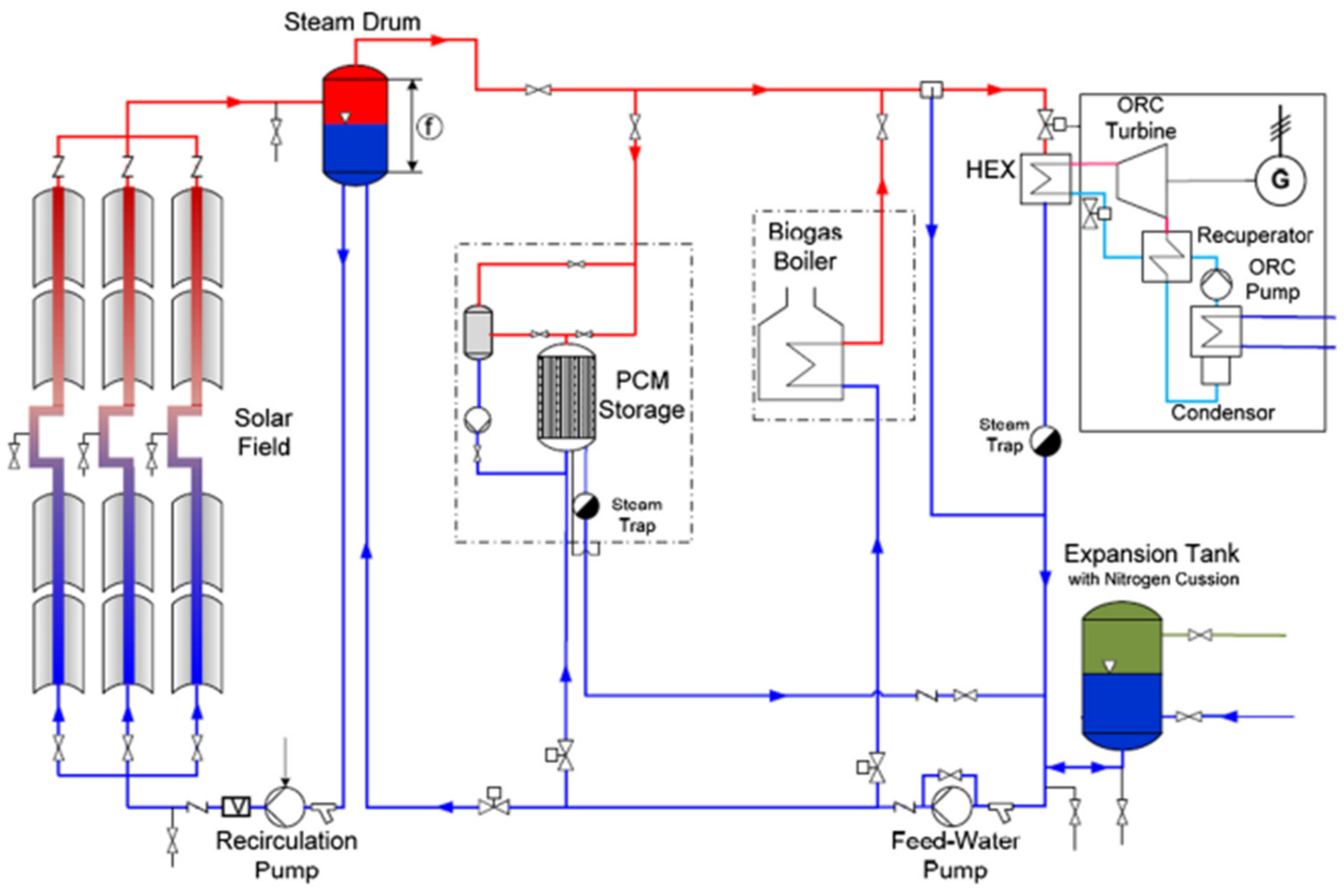


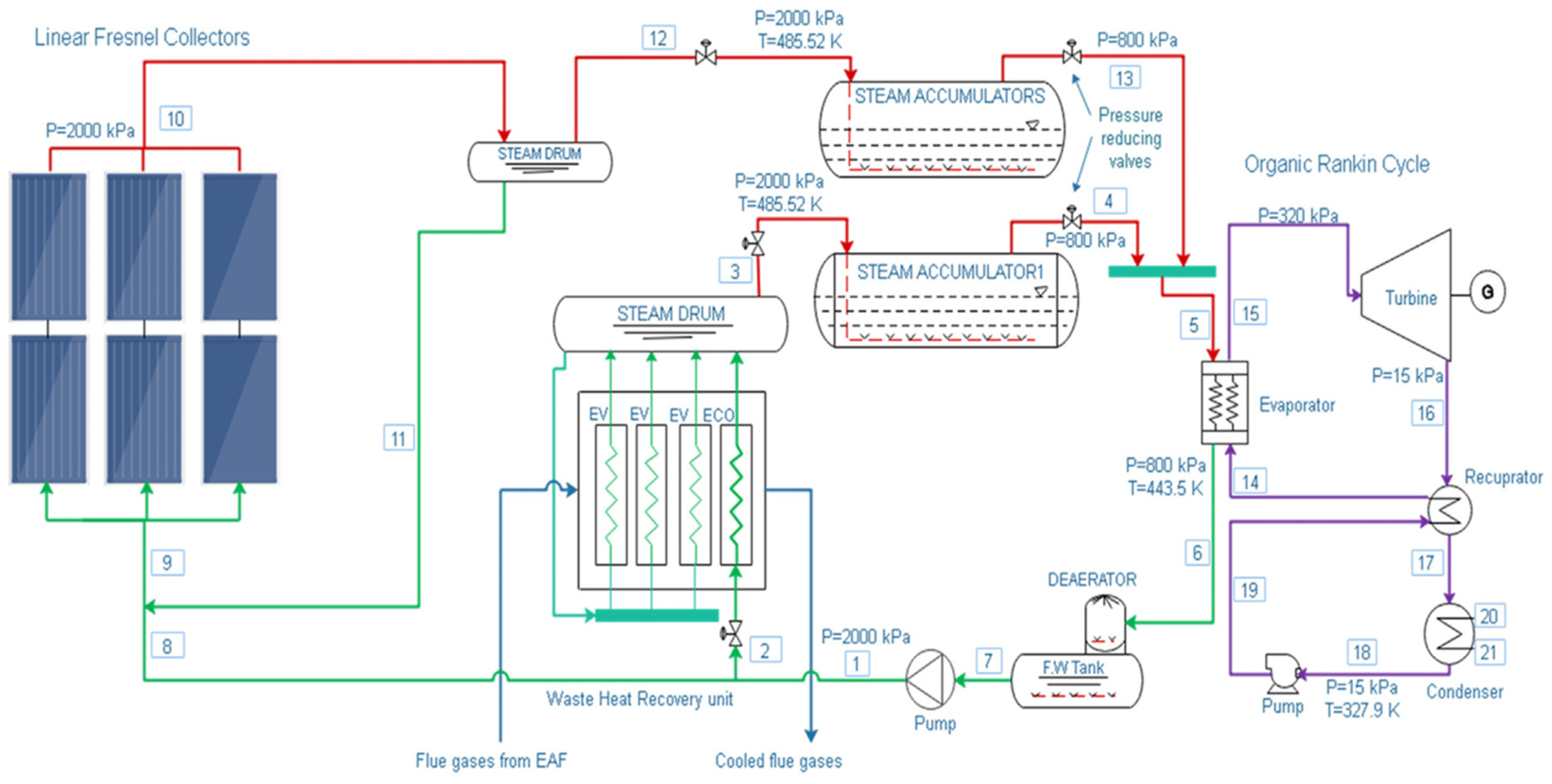
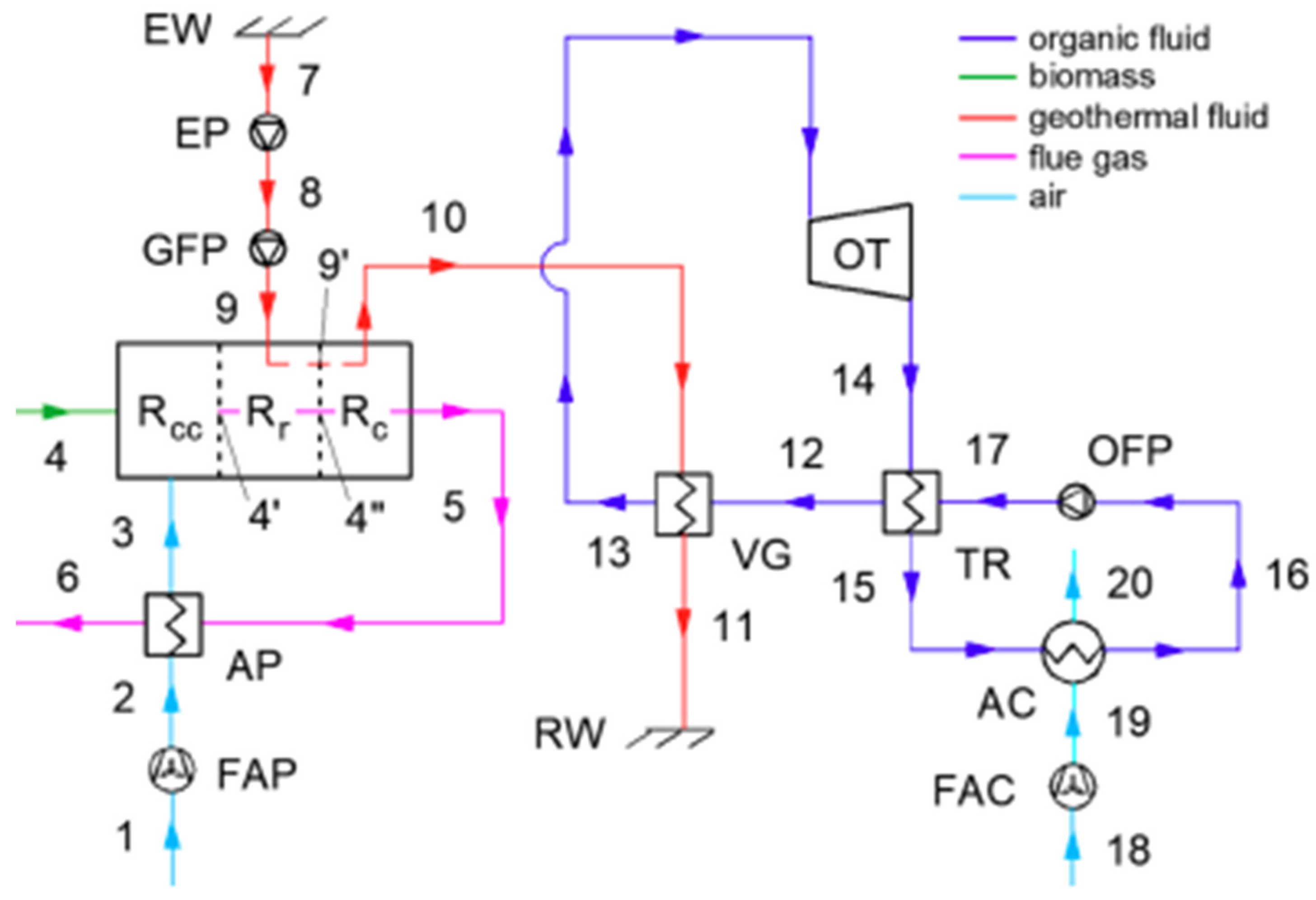
| Reference | Sources Combined | ORC Type and Working Fluids | Type of Hybridization | Results |
|---|---|---|---|---|
| Briola et al. [112] | Geothermal–Biomass | Subcritical RORC, R134a | Heat upgrade | ηORC = 26.76% ηsys = 10–22.9% LCOE = 0.105–0.113 EUR/kWh |
| Mahmood et al. [113] | Geothermal–Waste heat | Subcritical RORC, R123 | Waste heat ORC with geothermal condenser | ηORC = 12.89–15% PBP = 3.7–7.8 years |
| Ozcan and Ekici [114] | Geothermal–Waste heat | Subcritical Cascaded BORC, R115 | Geothermal topping cycle, waste heat bottoming | ηsys = 5.41% ηsys,ex = 28.67% LEC = 0.204 EUR/kWh |
| Toselli et al. [115] | Geothermal–Waste heat | Subcritical RORC, R245fa/R600a | Heat upgrade/series | Eseries = 35.51 GWh ηORC,series = 9.09% Eheat upgrade = 36.56 ηORC,heat upgrade = 8.88% LCOE = 0.1542 EUR/kWh |
| Reference | Sources Combination | Sources Configuration | Results |
|---|---|---|---|
| [48] | Solar–geothermal | Series | LCOE = 0.14–0.44 USD/kWh |
| [53,54] | Solar–geothermal | Series | ηORC = 21.63% ηex = 70.06% |
| [67] | Solar–geothermal | Heat upgrade | ηORC = 14% ηex = 52.5% LCOE = 0.118–0.171 USD/kW |
| [87,88,89,90,91] | Solar–biomass | Parallel | ηORC = 19.8% LCOE = 0.130–0.146 EUR/kWh |
| [97] | Solar–biomass | Heat upgrade | ηORC = 11% ηex = 55% LCOE = 0.098 USD/kWh |
| [106] | Solar–waste | Series | ηORC = 14.59% PBP = 2.88 years |
| [112] | Geothermal–biomass | Heat upgrade | ηORC = 26.76% ηsys = 10–22.9% LCOE = 0.105–0.113 EUR/kWh |
| [113] | Geothermal–waste heat | Geothermal condenser | ηORC = 15% PBP = 3.7–7.8 years |
Disclaimer/Publisher’s Note: The statements, opinions and data contained in all publications are solely those of the individual author(s) and contributor(s) and not of MDPI and/or the editor(s). MDPI and/or the editor(s) disclaim responsibility for any injury to people or property resulting from any ideas, methods, instructions or products referred to in the content. |
© 2025 by the authors. Licensee MDPI, Basel, Switzerland. This article is an open access article distributed under the terms and conditions of the Creative Commons Attribution (CC BY) license (https://creativecommons.org/licenses/by/4.0/).
Share and Cite
Gonidaki, D.; Bellos, E. A Detailed Review of Organic Rankine Cycles Driven by Combined Heat Sources. Energies 2025, 18, 526. https://doi.org/10.3390/en18030526
Gonidaki D, Bellos E. A Detailed Review of Organic Rankine Cycles Driven by Combined Heat Sources. Energies. 2025; 18(3):526. https://doi.org/10.3390/en18030526
Chicago/Turabian StyleGonidaki, Dimitra, and Evangelos Bellos. 2025. "A Detailed Review of Organic Rankine Cycles Driven by Combined Heat Sources" Energies 18, no. 3: 526. https://doi.org/10.3390/en18030526
APA StyleGonidaki, D., & Bellos, E. (2025). A Detailed Review of Organic Rankine Cycles Driven by Combined Heat Sources. Energies, 18(3), 526. https://doi.org/10.3390/en18030526








